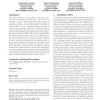6874 search results - page 1353 / 1375 » The future of human-computer interaction |
ICML
2000
IEEE
14 years 8 months ago
2000
IEEE
Eligibility traces have been shown to speed reinforcement learning, to make it more robust to hidden states, and to provide a link between Monte Carlo and temporal-difference meth...
POPL
2009
ACM
14 years 8 months ago
2009
ACM
Asynchronous or "event-driven" programming is a popular technique to efficiently and flexibly manage concurrent interactions. In these programs, the programmer can post ...
KDD
2008
ACM
14 years 8 months ago
2008
ACM
This paper presents a new algorithm for sequence prediction over long categorical event streams. The input to the algorithm is a set of target event types whose occurrences we wis...
CIVR
2009
Springer
14 years 8 months ago
2009
Springer
So far, most image mining was based on interactive querying. Although
such querying will remain important in the future, several
applications need image mining at such wide scale...
PERCOM
2003
ACM
14 years 7 months ago
2003
ACM
A mobile ad-hoc network is an autonomous system of mobile routers that are self-organizing and completely decentralized with no requirements for dedicated infrastructure support. ...

